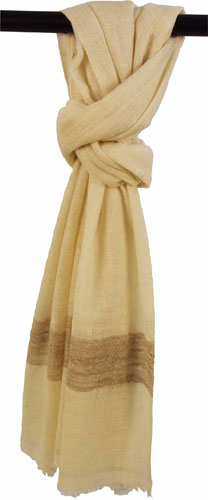
Khadi-Pashmina is a concept created by Discovering Roots. We use the traditional tools and techniques for hand-weaving khadi to make our pashmina that is eco-friendly and sustainable. Khadi-pashmina is the "purest" form of pashmina found nowhere in the world. It is unique in quality, adornments and style.
Khadi got importance from Mahatama Gandhi when he revived the 5000-year-old process of hand weaving khadi as a part of his movement of India's freedom fight in the 1920s. Though mainly woven in cotton, it can also be woven in silk and wool. In the past, "khadi" and "simplicity" were one and the same. Today, khadi has become a luxury brand synonymous to a fashion statement.
Pashmina (also called cashmere) is a very fine class of wool. Indian Pashmina is the finest; it is 12-14 micron whereas in other parts of Asia it is 16-17 micron. The textiles made from it were first woven in Kashmir and were entitled as "Soft Gold" in Kashmiri. The name comes from Persian pašmina, meaning "made from wool".
• The difference between pashmina and cashmere?
Pashmina is popularly known as cashmere in the USA, Europe and in other nations. But, you will be surprised to know that there are major technical differences between them. Besides swapping of terms for the sake of familiarity, pashmina and cashmere are sourced from high-altitude capra goat hair fiber sheared domestically. But, the pashmina yarn is strengthened with an organic homemade starch, whereas cashmere yarn undergoes carbonizing and is strengthened with nylon. Moreover, long and best grade fibers are sorted for Pashmina hand spinning, whereas, short and other grades of fibers along with long are used for cashmere spinning.
• How is Khadi-Pashmina different from machine-made pashmina?
Machine-made pashmina shawls are mixed with nylon or angora because pure pashmina is too weak to sustain the strain of mechanical weaving. Once the shawl is ready it is dipped in acid wash to remove the synthetic fiber. This may tear down the protein contained in pashmina fiber. On a traditional handloom "weaving process" takes 3-5 days whereas on a power loom it takes five minutes.
The rise of machine-made pashmina products has become big threat to the livelihood of the artisans who have been spinning and weaving pashmina for ages.
Khadi-Pashmina
-
1
-
2
-
3
